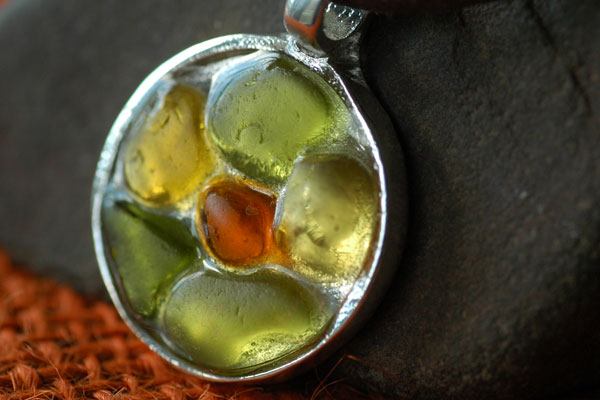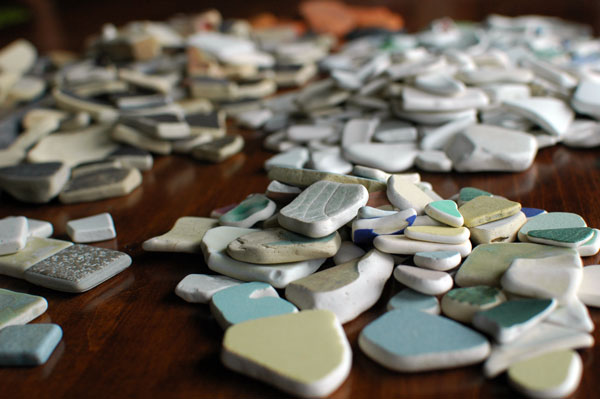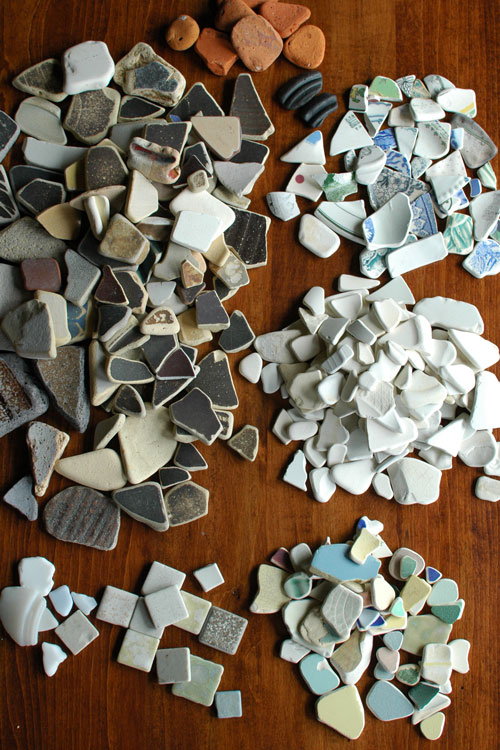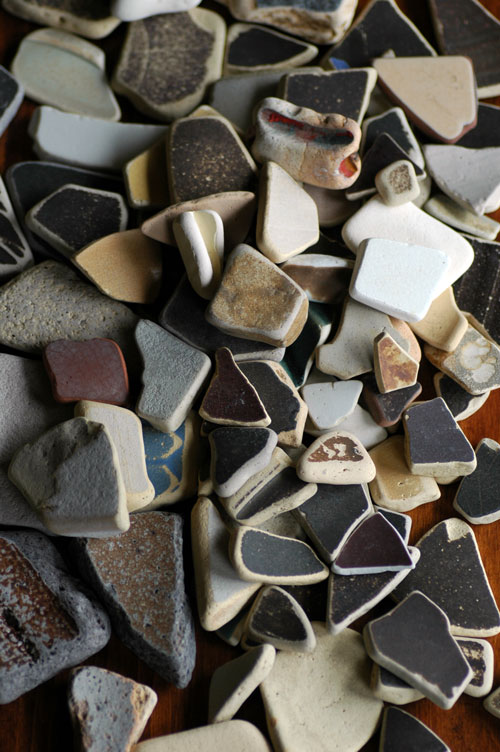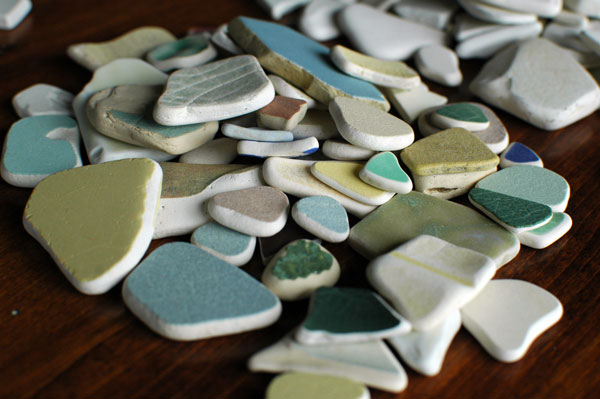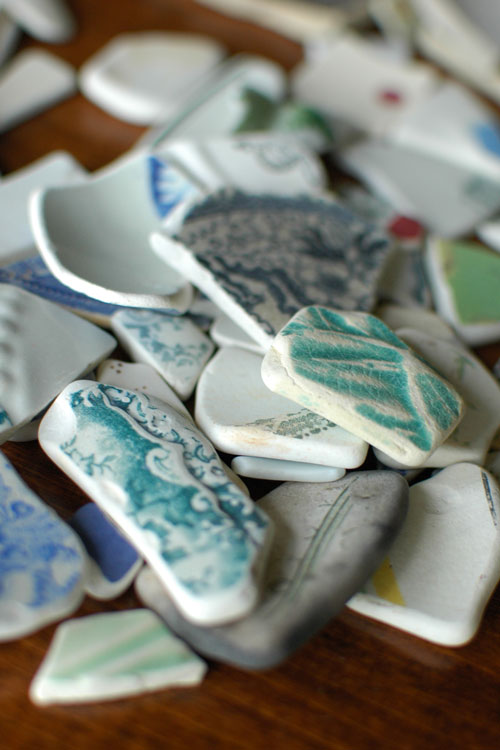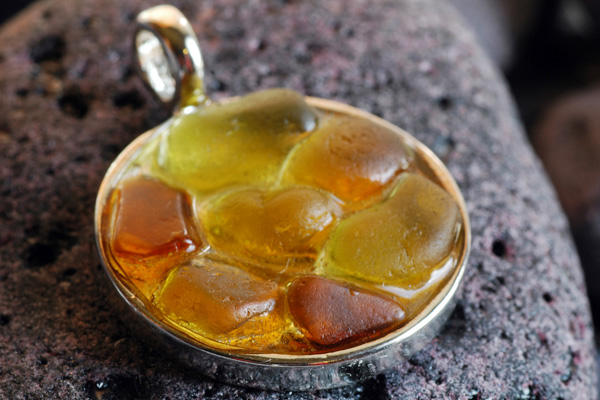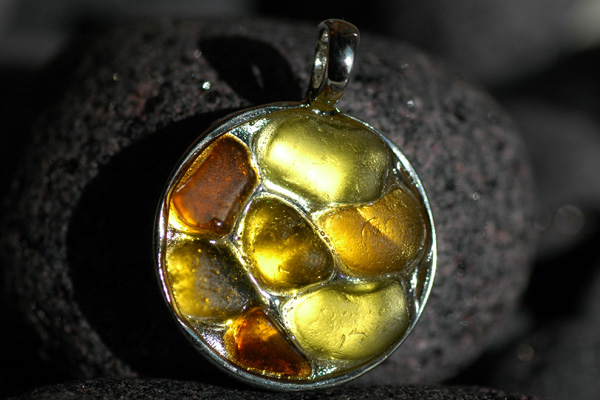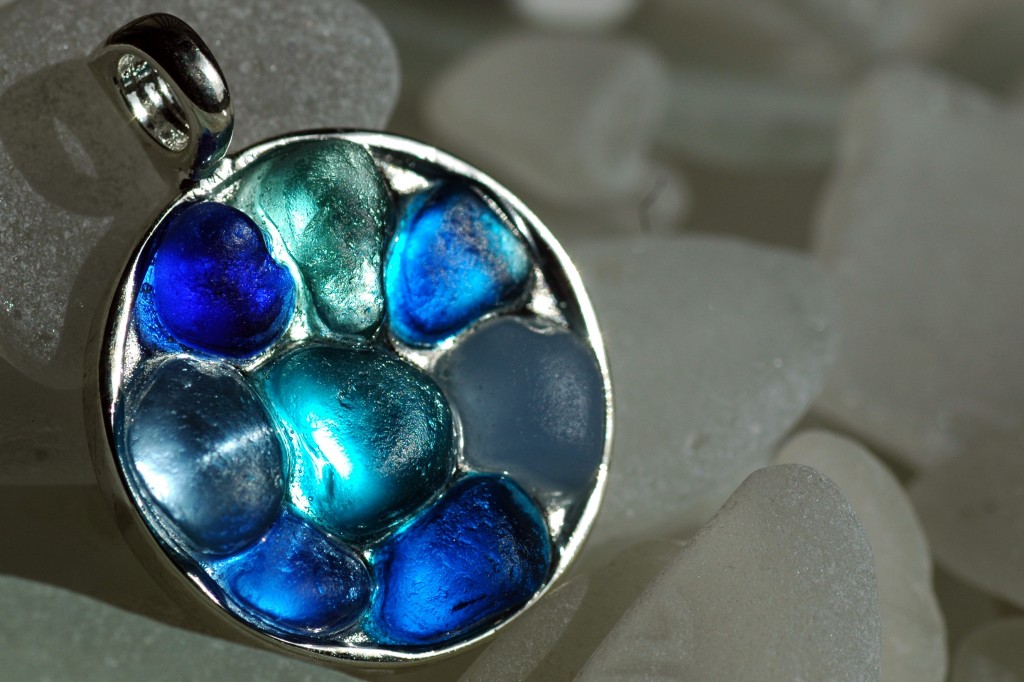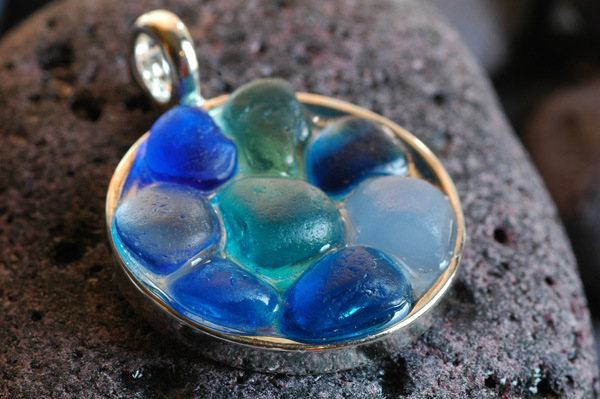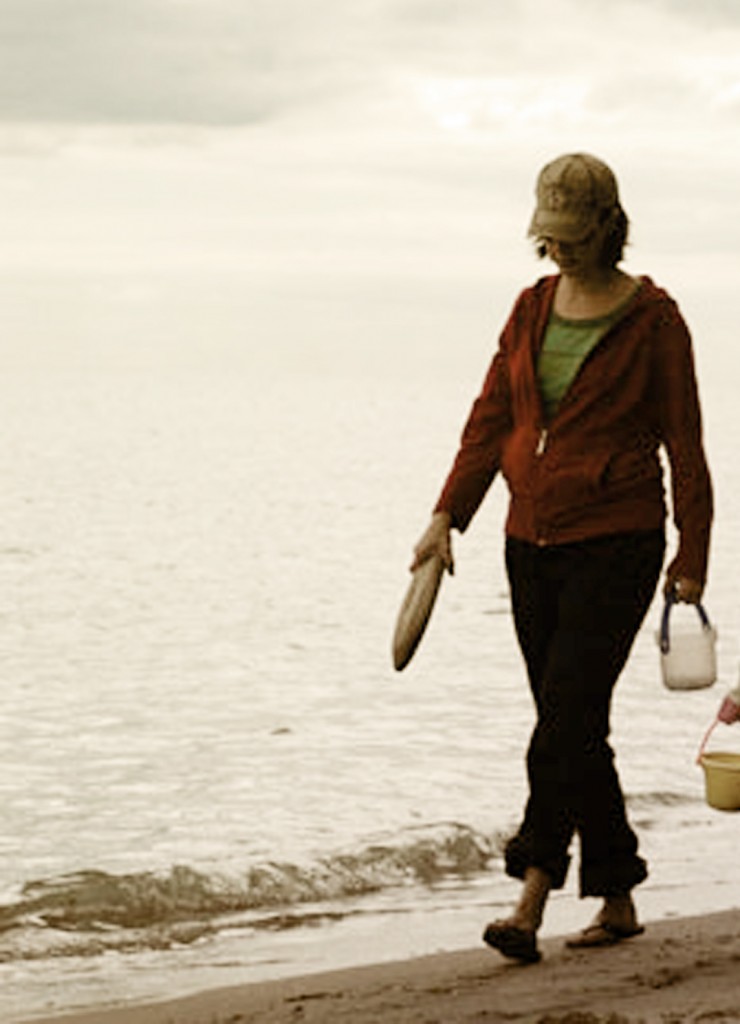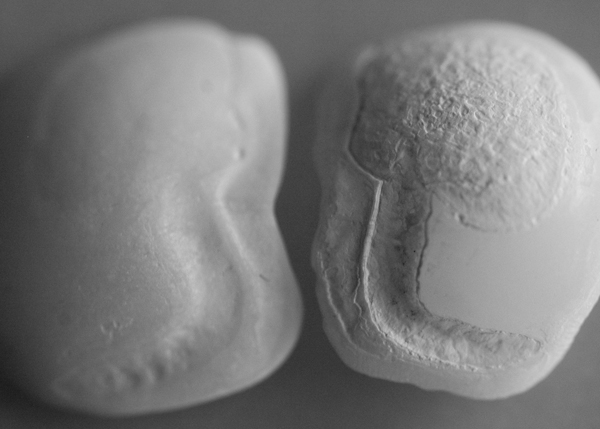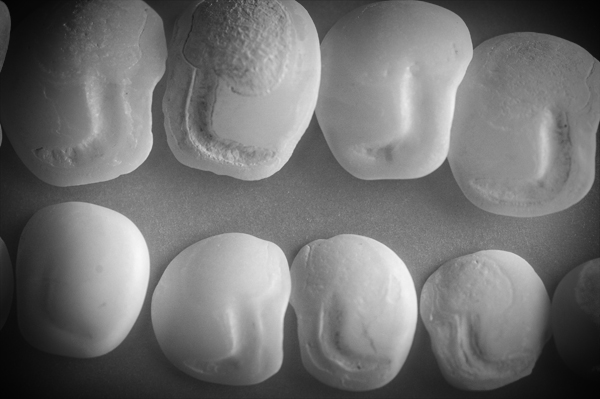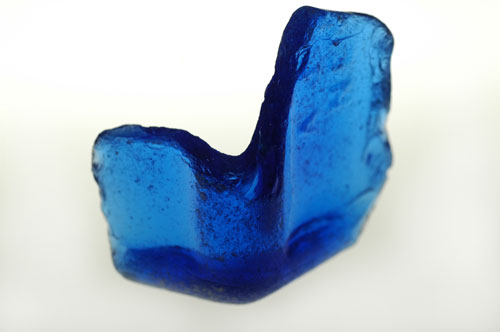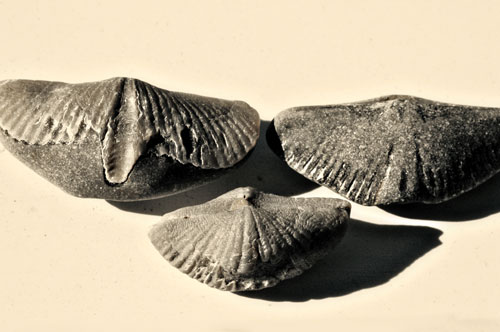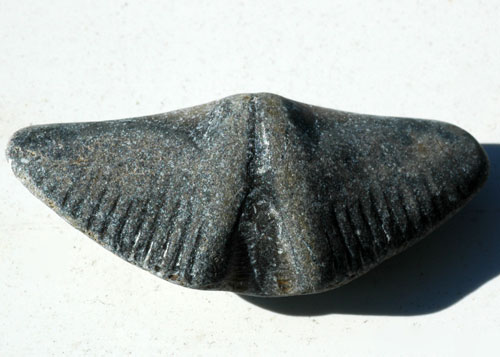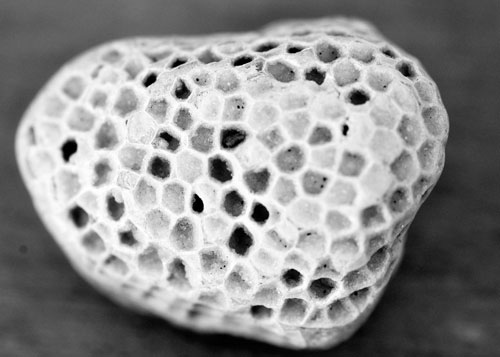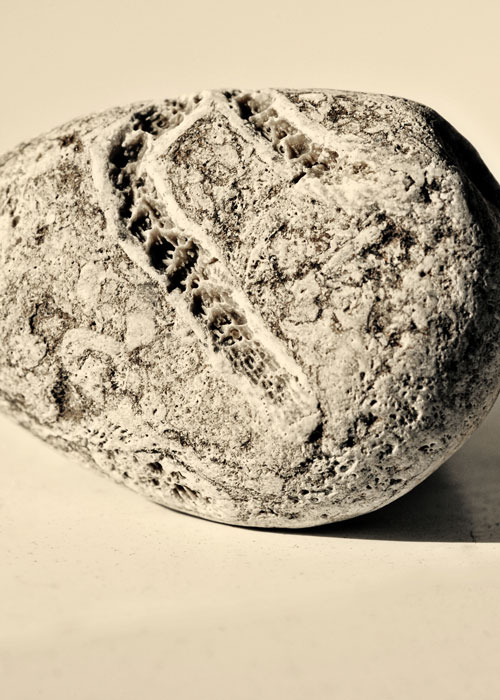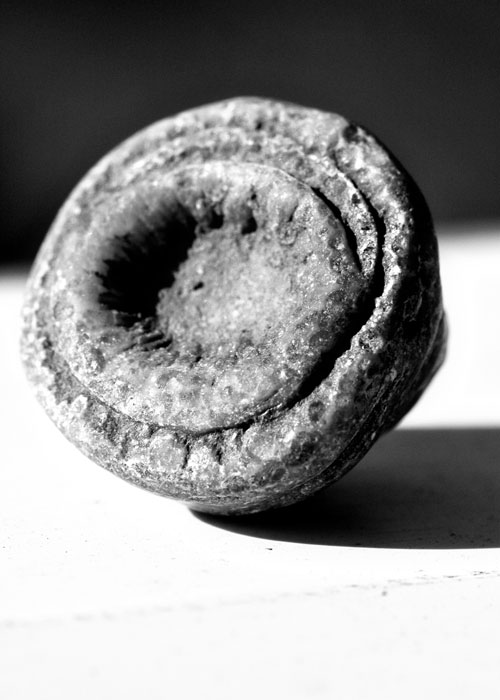White sea glass might be common, but perfectly frosted white chunks like this one are not!! I knew from the moment that I picked this one off of the beach that it would make the perfect pendant.
Come and check it out in my brandy new Etsy store.
This sea glass pendant mosaic is made with English Sea Glass. The glass is 90-160 years old. (The glass was found in an area that was once home to a couple of Victorian glass factories that operated from the 1850’s until the 1920s.) I have heaps and heaps of Lake Erie sea glass -which I love dearly, but oooooh laaaa laaaaa those English colours!!!!!!!!!
I will be opening my Etsy shop soon and will be selling these mosaic pendants.
This is the sea glass pottery that I have collected on the north shore of Lake Erie in the past year. The earthenware obviously outnumbers the other types of sea glass pottery shards.
There is something primal and beautiful about earthenware shards. I haven’t made anything with them (not sure that I will), but I love the look of them heaped together in a bowl. (I display them in a large clear bowl that we got as a wedding gift.)
Pottery shards in solid colours are always fun to find. I think the small ones would make lovely charms grouped together on a bracelet.
The biggest thrill is to find a piece of pottery with a pattern. Many of these would make superb pendants. But the prettiest ones are not mine. My daughters have keen eyes for pottery shards – they always seem to find the nicest ones.
There is something about English sea glass that makes me a little weak in the knees. I made these pendants with wee bits of English sea glass hand-plucked (by someone else) on Seaham Beach. These pendants make me a little delirious with delight, if I do say so myself. They make me think of Gothic stained glass windows drenched in sunlight.
Do you collect sea glass? Then you’ve witnessed that strange look in someone’s eyes that combines both bewilderment and boredom. Bewilderment because they can’t quite figure out why you are obsessed over bits of broken glass; and boredom because bits of broken glass are about as compelling to them as an electric garage door manual.
I do believe there are people in my extended family who have given me this look. (I won’t name any names.) For these folks, I limit my sea glass discussions to mere sentence fragments.
But maybe I am taking the wrong approach. Can they be enlightened? After all, sea glass has all the elements of a compelling collectible.
- Sea glass is mysterious. Was it from a shipwreck? Or maybe a poison bottle?
- Sea glass is beautiful. People rappel off of cliffs and kayak in dangerous waters in search of rare colors.
- Sea glass is historical. Some pieces are hundreds of years old!
- Sea glass is free – unlike many collectibles which can cost oodles of money.
- Sea glass is full of surprises. You never know what will end up in your bucket!
Thankfully, the people I spend most of my time with (my husband and two girls) are in just as deep as I am, so there’s no need for a lecture. There’s no need to explain to them why housework, homework and other obligations must take a back seat to hitting the beach. There’s no need to explain to them why the kitchen table is covered in a rainbow of wet glass instead of dinner.
There’s no need to help them understand why I can hear the Divine Spirit, or Source a lot more clearly in the sound of the waves, then inside four walls.
As architect Frank Lloyd Wright once said: “I put a capital “N” on nature and call it my church.”
I love a church where I can wear rubber boots and smell the wind.
I was scouring the beach for sea glass when two women walked by.
“Not many lucky stones today,” the taller one said to me.
Hmmm. What are lucky stones, I wondered? The women were long gone before I could ask them.
When I got home I headed online to do some research. And I found bones.
The lucky stones I’m sure the two women were referring to that day over a year ago are otoliths, or ear bones from sheepshead fish. They are found along the shores of Lake Erie.
Apparently, indigenous people used them as amulets and fishermen put them in their pockets for good luck.
Whether you are superstitious or not, there’s no denying that lucky stones or “ear stones” truly are remarkable. In fact there are scientists who devote their entire working lives to studying them.
Otoliths provide a wealth of scientific data. In fact, they are referred to as the “black box” or ‘flight recorder” of a fish. Not only does an otolith tell a fish’s age (each year is represented by a ring, just like a tree), but also very detailed information about the fish’s health, habitat and diet. As D. Graham Burnett writes in Cabinet Magazine: (do check out the rest of this excellent article on otoliths)
… about thirty years ago a curious geologist, tinkering with an otolith (it was a rock, after all), made the truly shocking discovery that those annual layers can be further resolved, microscopically, down to daily layers, layers that contain, in their chemical composition and size, information about the temperature and the salinity of the water through which the fish moved, the food that it ate, and various environmental contaminants it encountered. The result is a stratigraphy unprecedented in the organic world: the diligent student can peruse the otolith of a long-lived deep sea fish, and reconstruct not merely its age, but (and I am barely exaggerating) what it had for breakfast on 6 March 1964, or roughly where it was on the occasion of a particular nuclear test.
Interestingly, each stone has either an “L” shape or a “J” (which stands for “Love and Joy”, according to some collectors.) The “L” shaped bones are from the right side of the fish, while the “J” is from the left side.
Some collectors make jewelry out of Lucky Stones. Alison over at Lucky Stone Jewelry is a cancer survivor – and collecting and making jewelry from lucky stones is part of the healing process for her. Check out her story and her wonderful creations here.
I had a nice collection of lucky stones – until this afternoon, when my collection blew into the wooden cracks of my front porch while I was trying to photograph them. (The photos above were snapped before the wind took them.) I have two left.
Yet another excuse to hit the beach this weekend.
What’s better than finding a piece of cobalt blue sea glass on the beach? Your five-year old finding a piece of cobalt blue sea glass on the beach.
The shrieks of delight and enthusiasm from my daughter still echo in that happy place in my brain where good memories are filed away for keeps.
She found it a couple of weeks ago under a driftwood log.
“Look what I found mom!!!” she announced, holding up the piece as if it were the Devil’s Eye Diamond from The Rescuers.
Maddie knows that big chunks of cobalt blue sea glass are hard to come by – especially ones with words on them.
Today I did some research on the piece. I simply plunked in “A. J + cobalt blue bottle” into Google, and presto-mundo (the internet really is magic!) – there it was: a Laxol bottle.
Yes, it’s a laxative. And likely more than 100 years old. My daughter will get a serious kick of these two facts.
The bottle was from A. J. White (Andrew Judson White), New York. A. J. was a proprietary medicine maker in New York City who teamed up with the Shakers in New York to produce medicines using botanical ingredients supplied by the Shakers. In 1957, A. J. White was purchased by Smith, Kline and French Laboratories.
You know you’ve got it bad when a laxative bottle (or piece of it) turns your crank.
There is something surreal about holding something that is hundreds of millions of years old. Somehow it puts my tiny life into perspective.
My fascination with fossils is relatively new. A few years ago I was like most people, not giving them a second thought. But then I started finding them along the shores of Lake Erie while sea glassing. What are these odd little rocks with the strange patterns? What were these petrified creatures? How did they end up here?
My collection fills a small mason jar and I’m just beginning to research the history of these fascinating stones. Here are a few of my favourites:
These are brachiopods. Hundreds of millions of years old. My daughter thinks they look like bats (she’s got Halloween on the brain these days.)
Sea coral. Very old sea coral. This has tiny, glitter-like crystals inside each honeycomb. Gorgeous in the sunlight.
I don’t know what this is yet. It reminds me of a rattlesnake.
Did someone leave a belly button on the beach? Ew. Any ideas what this is?



